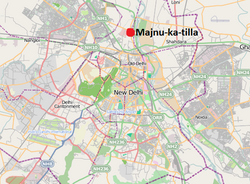Majnu Ka Tilla
|
Majnu-ka-tilla New Aruna Nagar Colony, Samyeling |
|
|---|---|
| Neighbourhood | |

View from rooftop in Majnu-ka-tilla
|
|
 Location of Majnu-ka-tilla in Delhi |
|
| Coordinates: 28°42′05″N 77°13′41″E / 28.70137°N 77.22816°ECoordinates: 28°42′05″N 77°13′41″E / 28.70137°N 77.22816°E | |
| Country |
|
| State | Delhi |
| District | North Delhi |
| Established | 1960 |
| Population (2000) | |
| • Total | 2,500 |
| Time zone | Indian Standard Time (UTC+5:30) |
| Pincode(s) | 1100054 |
| Area code(s) | +91 11 |
Majnu-ka-tilla (MT) is a Tibetan colony in Delhi, India that was established around 1960. Majnu-ka-tilla is officially called New Aruna Nagar Colony,Chungtown, and Samyeling. It is part of North Delhi district and is located between the Yamuna River and Delhi's Outer Ring Road (NH-1) near ISBT Kashmiri Gate.
The historic name of area, literally means the hillock of Majnu, after the tilla or mound where during the reign of Sikandar Lodhi (r. 1489–1517) on Delhi Sultanate, a local Iranian Sufi mystic, Abdulla nicknamed Majnu (lost in love), met Sikh Guru, Guru Nanak on July 20, 1505. Majnu ferried people across the Yamuna river for free as a service to God, his devotion resulted in the Nanak staying here till end July. In later history Sikh military leader Baghel Singh built the Majnu ka Tila Gurudwara to commemorate the stay in 1783, and the sixth Sikh guru, Guru Har Gobind also stayed here. Today it is one of oldest extant Sikh shrines in Delhi and the surrounding estate of donated by early 19th-century Sikh emperor, Ranjit Singh.
Majnu Ka Tilla area has three main residential settlements with total 3000–3500 homes, Aruna Nagar, New Aruna Nagar and Old Chandrawal village, which was built up in early 1900s, when British government settled labourers involved in the construction of the Central Secretariat buildings, during the construction of the New Delhi. The next round of settlement came post-independence in 1958-59, when Aruna Nagar was developed by the Land and Development wing of the Ministry of Urban Development as it disburses 925 plots of 40 sq. yard each, to people resettled here from various part of North Delhi. The Tibetan refugee camp later named New Aruna Nagar developed after 1960, and more recently two large jhuggi jhopari (hutment) clusters have developed on the periphery.
...
Wikipedia
